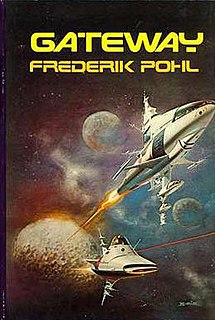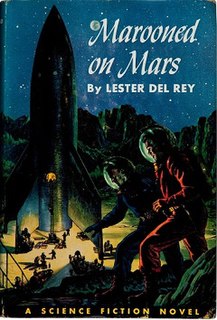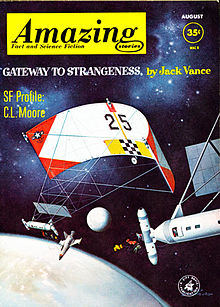
Dying Earth is a fantasy series by the American author Jack Vance, comprising four books originally published from 1950 to 1984. Some have been called picaresque. They vary from short story collections to a fix-up, perhaps all the way to novel.

Interplanetary spaceflight or interplanetary travel is the crewed or uncrewed travel between stars and planets, usually within a single planetary system. In practice, spaceflights of this type are confined to travel between the planets of the Solar System. Uncrewed space probes have flown to all the observed planets in the Solar System as well as to dwarf planets Pluto and Ceres, and several asteroids. Orbiters and landers return more information than fly-by missions. Crewed flights have landed on the Moon and have been planned, from time to time, for Mars and Venus. While many scientists appreciate the knowledge value that uncrewed flights provide, the value of crewed missions is more controversial. Science fiction writers propose a number of benefits, including the mining of asteroids, access to solar power, and room for colonization in the event of an Earth catastrophe.

Solar sails are a method of spacecraft propulsion using radiation pressure exerted by sunlight on large mirrors. A number of spaceflight missions to test solar propulsion and navigation have been proposed since the 1980s. The first spacecraft to make use of the technology was IKAROS, launched in 2010.

John Holbrook "Jack" Vance was an American mystery, fantasy, and science fiction writer. Though most of his work has been published under the name Jack Vance, he also wrote several mystery novels under different pen names.
"Misfit" is a science fiction short story by American writer Robert A. Heinlein. It was originally titled "Cosmic Construction Corps" before being renamed by the editor John W. Campbell and published in the November 1939 issue of Astounding Science Fiction. "Misfit" was Heinlein's second published story. One of the earliest of Heinlein's Future History stories, it was later included in the collections Revolt in 2100 and The Past Through Tomorrow.

The Rolling Stones is a 1952 science fiction novel by American writer Robert A. Heinlein.

The Patchwork Girl is a science fiction novel by American writer Larry Niven. Part of his Known Space series, it is the fourth of five Gil Hamilton detective stories and the first to be published as a stand-alone novel in 1980. It was later included in the Gil Hamilton anthology Flatlander.

The Wind from the Sun (ISBN 0-15-196810-1) is a 1972 collection of science fiction short stories by British writer Arthur C. Clarke. Some of the stories originally appeared in a number of different publications. A part of the book was included in CD on board the Planetary Society's solar sail, Cosmos 1.
The Gaean Reach is a fictional region in space that is a setting for some science fiction by Jack Vance. All of his series and standalone works that are set in a universe evidently including the Gaean Reach, perhaps set inside it or outside it, have been catalogued as the Gaean Reach series or super-series.

Inconstant Moon is a science fiction short story collection by American author Larry Niven that was published in 1973. "Inconstant Moon" is also a 1971 short story that is included in the collection. The title refers to "O, swear not by the moon, th' inconstant moon", a quote from the balcony scene in William Shakespeare's Romeo and Juliet. The collection was assembled from the US collections The Shape of Space and All the Myriad Ways.

Gateway is a 1977 science fiction novel by American writer Frederik Pohl. It is the opening novel in the Heechee saga, with four sequels that followed. Gateway won the 1978 Hugo Award for Best Novel, the 1978 Locus Award for Best Novel, the 1977 Nebula Award for Best Novel, and the 1978 John W. Campbell Memorial Award for Best Science Fiction Novel. The novel was adapted into a computer game in 1992.
Asteroids and asteroid belts are a staple of science fiction stories. Asteroids play several potential roles in science fiction, most notably as places which human beings might colonize, as resources for extracting minerals, as a hazard encountered by spaceships traveling between two other points, and as a threat to life on Earth due to potential impacts.

Battle Beyond the Sun is the English-dubbed and re-edited U.S. version of Nebo Zovyot, a 1959 Soviet science fiction film. Roger Corman acquired the Soviet film for US distribution and hired a young film-school student named Francis Ford Coppola to Americanize it. It is still a tale of the "space race", of two nations competing to become the first to land a spacecraft on the planet Mars, but switches the competing nations, via the dubbing, from the USSR and the USA to the fictional future countries of North Hemis and South Hemis. The names of not only the Soviet characters, but also their performers, and the crew credits as well, were altered on the screen to American-sounding names in order to further disguise the film's origins: thus Soviet stars Aleksandr Shvorin and Ivan Pereverzev became "Andy Stewart" and "Edd Perry", and Soviet directors Mikhail Karyukov and Aleksandr Kozyr became "Maurice Kaplin" and "Arthur Corwin" - and were demoted to Assistant Director status as well. The advertising and release print's designated Director is given as Thomas Colchart; sources vary as to whom that name actually belongs.
A significant number of science fiction works have explored the imaginative possibilities of binary or multiple star systems. Many real stars near the Sun belong in this category.

The Five Gold Bands is a science fiction novel by American writer Jack Vance, first published in the November 1950 issue of Startling Stories magazine. It was published in 1953 as a separate book under the title The Space Pirate, and in 1963 it was paired with Vance's Hugo Award-winning novella The Dragon Masters in the form of an Ace Double.

Marooned on Mars is a juvenile science fiction novel written by American writer Lester del Rey. It was published by John C. Winston Co. in 1952 with illustrations by Alex Schomburg.

The Mars Project is a 1952 non-fiction scientific book by the German rocket physicist, astronautics engineer and space architect, Wernher von Braun. It was translated from the original German by Henry J. White and first published in English by the University of Illinois Press in 1953.

Marune: Alastor 933 (1975) is a science fiction novel by Jack Vance, the second of three books set in the Alastor Cluster, ‘a whorl of thirty thousand stars in an irregular volume twenty to thirty light-years in diameter’. Three thousand of the star systems are inhabited by five trillion humans, ruled by the mostly hands-off, laissez-faire Connatic, who occasionally, in the manner of Harun al-Rashid of The Thousand and One Nights, goes among his people in disguise. The novel was preceded by Trullion: Alastor 2262 (1973) and followed by Wyst: Alastor 1716 (1978).

Great Stories of Space Travel is an anthology of science fiction short stories edited by Groff Conklin. It was first published in paperback by Tempo Books in July 1963, and reprinted by the same publisher in December 1965, 1969, and April 1970.















